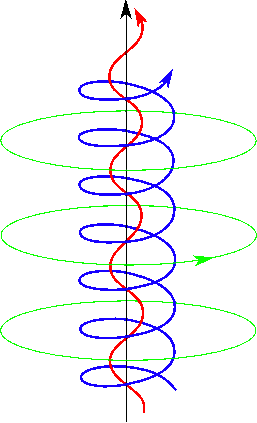Magnetic Flux Ropes
© Charles ChandlerScientists speak of magnetic ropes as if they were physical entities with some sort of tensile strength, capable of funneling energy from the Sun to the Earth. And what kind of energy would that be? Magnetic energy, of course.Figure 1. B-field aligned current in a low-density plasma, popularly known as a magnetic rope, courtesy NASA.In actuality, magnetic fields are not like a substance that can be stretched, or twisted around itself and still stay organized. Magnetic fields are generated by moving electric charges. Things get interesting when charges move within the influence of an external magnetic field, such as the Earth's.1 (See Figure 1.) The Lorentz force induces rotation around the magnetic lines of force, such that the fields generated by the moving charges line up with the external field. Electrons, being lighter, experience a more dramatic effect, and their spiraling generates synchrotron emissions, while positive ions emit slower waves, in the radio band. In a lossy and somewhat confusing reduction, these currents are called magnetic flux ropes, neglecting the cause and promoting the effects to prime movers. But "magnetic ropes" are not "conduits for solar wind energy." These are electric currents, which are motivated by electrostatic potentials. The magnetic fields generated by these currents organize the drifting particles, but are not themselves the source of the energy.Analogously, one might say that children seem to follow trails of empty candy wrappers from one play room to the next. These are sometimes called candy wrapper flux tubes (CWFT), and are believed to transport children throughout the daycare center. But it would be more accurate to say that the children go from one play room to the next in search of new toys, and just happen to leave a trail of candy wrappers wherever they go. Once the wrappers begin to pile up, it's just easier to follow the same path, rather than tripping and falling when attempting to break out of a CWFT. So first and foremost, the "flux tubes" are effects, while they do cause some consolidation of the child flow.Likewise, electric currents are motivated by electric fields, and just happen to generate magnetic fields as they go. The magnetic pinch effect consolidates these currents. And when such currents encounter existing magnetic fields from some other source (such as the Earth), Lorentz forces deflect the charged particles. But it is not accurate to think of "flux tubes" as permanent features that came from nowhere, and then dominate whatever particle motions happen to emerge.
References
1. Alfvén, H.; Arrhenius, G. (1976): Evolution of the Solar System. NASA, SP-345 ⇧











